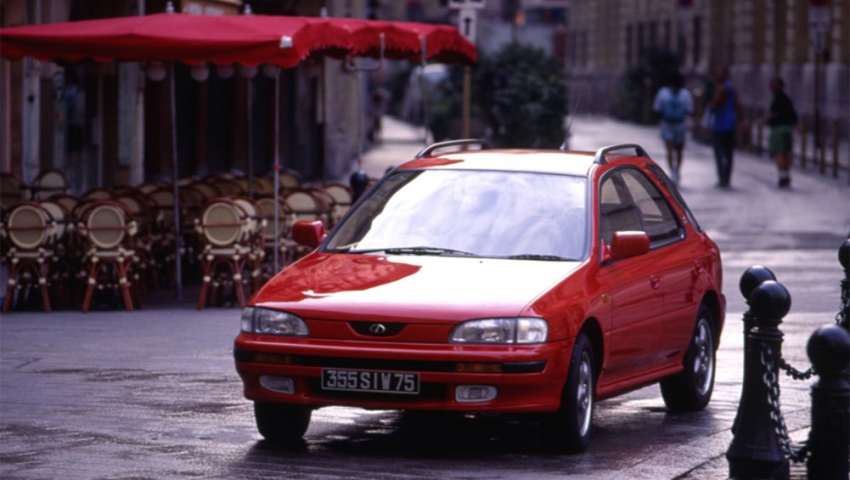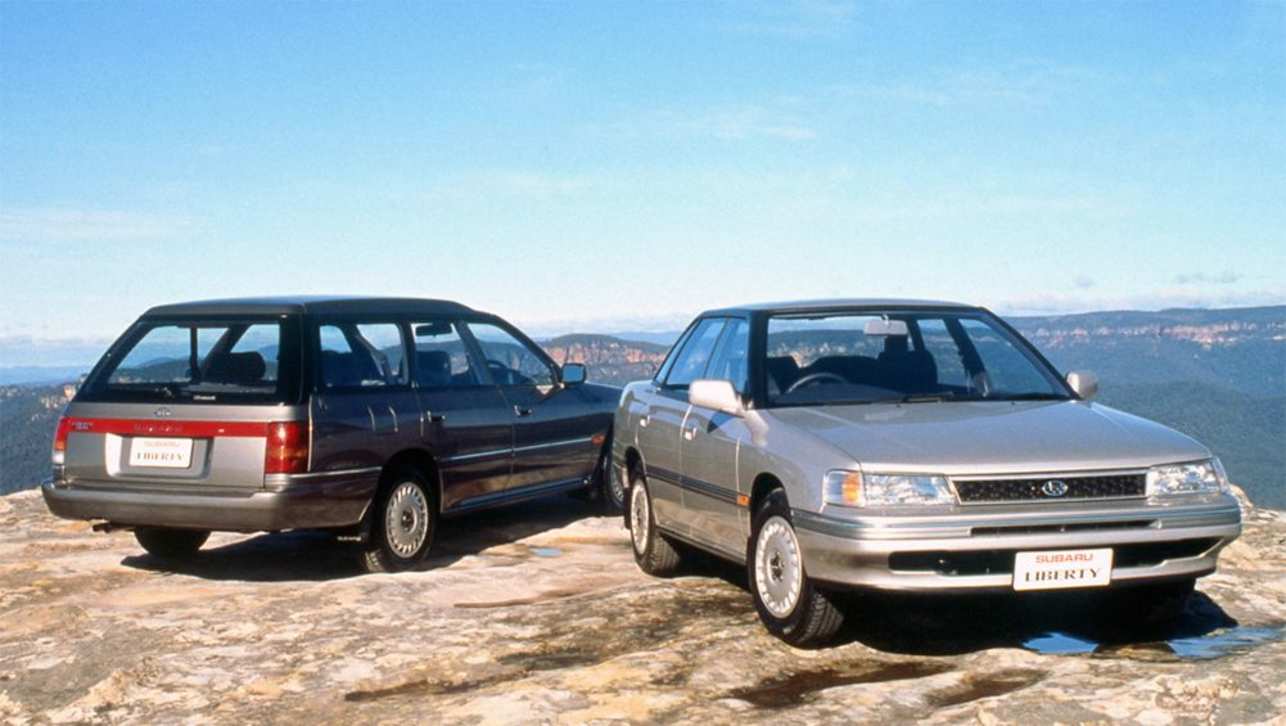To say the Subaru Liberty/Legacy lived up to its name is like saying The Beatles influenced popular music.
With production ending in 2025 after 36 influential years, the midsized flat-four (and sometimes flat-six) cylinder sedan and wagon range – like the other fab four – changed not just the company, but also its class, the market and, ultimately, even the wider world, in important and even culturally significant ways.
We’re not taking liberties with the facts here, either, because the Japanese minnow that is Subaru gambled everything by creating a model based on the daring concept of architectural flexibility and modularity, setting the template for others to follow later on.
Yes, Australian imports ceased by 2020 – more on that later on – but with the series now retiring worldwide, here are the 10 major legacies left by the Subaru Australians know as Liberty (which we'll also explain why).
Let’s go!
1. Liberty saved Subaru
Before the Liberty’s late-1989 launch, Subaru was really struggling.
Known for niche oddities like the farmer-favourite Brumby ute and futuristic Vortex coupe, sales of the mainstream Toyota Corolla-rivalling Leone had slumped due to dreary styling, cramped packaging and poor refinement. The brand was fading fast.
New from the ground up, the ambitious Liberty had to succeed then, especially as the world was starting to slide into recession. Luckily for Subaru, both public and press reaction exceeded expectations, with the newly-sophisticated, value-packed and award-winning newcomer managing to steal sales from Honda, BMW and Mercedes. Perfect timing. And the model’s winning streak did not let up for 20 years.

When it did, the story of why is all-too-familiar in a world overrun with SUVs and too few buyers are choosing sedans, leaving the midsized Subaru to follow scores of rivals like the Ford Mondeo, Opel Insignia, Nissan Bluebird and Renault Laguna into oblivion.
So, why did the name change in Australia? Subaru’s importers chose Liberty to circumvent backlash from war-veteran organisation Legacy being affronted by a Japanese car wearing that badge. We're talking 35 years ago now.
2. Liberty cemented Subaru’s signature DNA
Subaru had been making modest horizontally-opposed flat-four “boxer” engines since the 1960s, but the Liberty debuted the now-legendary EJ boxer units that bore little resemblance to what came before, with varying capacities that powered scores of naturally-aspirated and turbocharged models, and remained in production until 2021.

Likewise, it introduced full-time all-wheel drive that later became synonymous with the brand as “Symmetrical AWD” (though front-wheel drive models were also produced), switched to five (rather than four) stud wheels and banished the trademark spare-wheel in the engine bay.
To appease Subaru traditionalists, at least the Liberty retained a high-roof wagon shape option like the old Leonie had, as well as frameless doors up until 2009’s fifth-gen version that grew a size to chase Toyota Camry sales in America. More's the pity.
3. Liberty read the room
Perfect timing saw Liberty address serious cost-of-living crisis concerns following the devastating early-1990s recession. In Australia, if you needed a family car with AWD, an expensive Audi or cumbersome 4WD like a Range Rover were your lot until the Subaru came along. SUVs were still some way off.

But it wasn’t just premium brands that felt the heat, since the affordable Liberty also snared sales from the mainstream Commodore, Falcon, Camry, Mitsubishi Magna and Mazda 626. Subaru was on a roll!
4. Liberty leaned into rallying
As the Legacy Turbo, the first Liberty dominated international rallying, while the press declared the road-going Liberty RS turbo a cut-price Audi Quattro-esque performance bargain. And why not? The tech underneath delivered in spades.

Which must have given Subaru’s product planners a great big small idea…
5. Liberty spawned Impreza
Part of the Liberty’s development criteria was to create greater platform flexibility to contain costs and leverage larger economies of scale.
As a replacement for the hopelessly-dated Leonie, the original Impreza for 1993 was essentially a Liberty, but downsized and redesigned for smaller-car loving markets around the world like Europe.

Youthful yet distinctive, it was a massive improvement, aided by all the Liberty tech transfer that ultimately brought on a derivative that became an international superstar beyond the confines of the car industry.
6. Liberty ushered in WRX
The first-gen Impreza Turbo/WRX from 1994 to 2000 reset the affordable performance-car paradigm at a time of economic uncertainty and dreary hot hatches (remember the Golf GTIs of the '90s?).
That it quickly made the Liberty RS Turbo redundant must have been a bittersweet outcome, but the WRX's unforeseen ascension to PlayStation superstardom broke new ground.

Transcending from bargain pocket-rocket to cultural phenomenon wasn't just limited to gaming or rallying domination either, as the WRX also seemed to be the wheels of choice for ravers, ram-raiders and rozzers.
A Nissan Skyline GT-R for Generation X, then, and we all have daddy Liberty to thank.
7. Liberty introduced the Outback
This fact cannot be overstated enough.
While you can see its genesis in the Leonie Touring Wagon of the prior decade, the second-gen Liberty wagon-based Outback of the mid-‘90s seemed to tilt the earth on its axis, breaking the brand into fresh markets and stealing buyers away from the-then crude 4x4 wagons that it often undercut (and out-performed in almost every category).

And, in another case of perfect timing, the high-riding, plastic-cladded Subaru hitched a ride on the SUV rocketship piloted by the pioneering Toyota RAV4.
Invariably, many other manufacturers have tried to emulate the Outback formula’s success in their corresponding wagon models, but somehow not even the Audi Allroad has managed the critical mass that this now-standalone model enjoys worldwide.
That it thrives today when almost every other midsized competitor to the Liberty has gone – including the Liberty itself since right-hand-drive production ceased in 2020 when the sixth-generation was launched as a North American-only model – proves the brilliance behind this concept.
8. Liberty brought us Forester
Why stop at Impreza?
It seems that the Forester of 1997, as Subaru’s answer to the all-conquering RAV4, could well have been the Liberty's greatest achievement for the brand.

Within five years the resulting tide of medium-sized SUVs obliterated medium-sized sedan and wagon sales, and another decade after that you can argue that their most prized scalps in Australia were the Falcon and Commodore.
The Forester has long been Subaru’s bestseller locally, and is regarded as one of the trio of soft-roader SUV originals along with the RAV4 and Honda CR-V that helped prise open this class of vehicle from the latter ‘90s.
9. The famous failures Liberty created
While today it is highly sought after in some circles, back in the early '90s, the wildly ambitious SVX coupe was a rare Liberty-based misfire – and a true Subaru in its breathtaking boldness.

Also designed by Italian legend Giorgetto Giugiaro, the large coupe flummoxed consumers with its jet-fighter canopy-style turret and high pricing (especially compared to the Leonie-based Vortex that it replaced), while the horizontally-opposed six-cylinder engine promised more than it delivered. Still, how cool is the SVX today?
Meanwhile, in 2005, the fourth-gen Liberty ushered in the striking Tribeca, an American-made seven-seater SUV answer to the Toyota Kluger.

Styled by an ex-Alfa Romeo designer, its aircraft-motif nosecone divided critics and buyers alike, forcing Subaru to graft on another front end look just two years later that was originally created for the abandoned Saab 9-6X version
And although Australians bought the Tribeca in quite decent numbers until production ended in 2013, Subaru did not bother re-engineering its US-market Ascent replacement – another Liberty-based model – when that surfaced some five years later.
10. Liberty begat BRZ
While it’s a stretch to say that the BRZ and its Toyota 86 twin released to universal acclaim in 2012 are directly based on the Liberty, the latter’s aforementioned architectural components dating all the way back to the 1989 original were modified extensively to help create the wonderful little sports cars that remain in production to this day. It’s all in the DNA.

Affordable sports cars are pretty rare on the ground nowadays, but thanks to Subaru’s ingenuity when the chips were down 35 years ago, in 2024 we’re lucky enough for this incredible pair of motoring treasures.




-2.jpg)


.jpg)

.jpg)
.jpg)



.jpg)
.jpg)

.jpg)
.jpg)
.jpg)

_0.jpg)

.jpg)

.jpg)
.jpg)



.jpg)
.jpg)
Comments